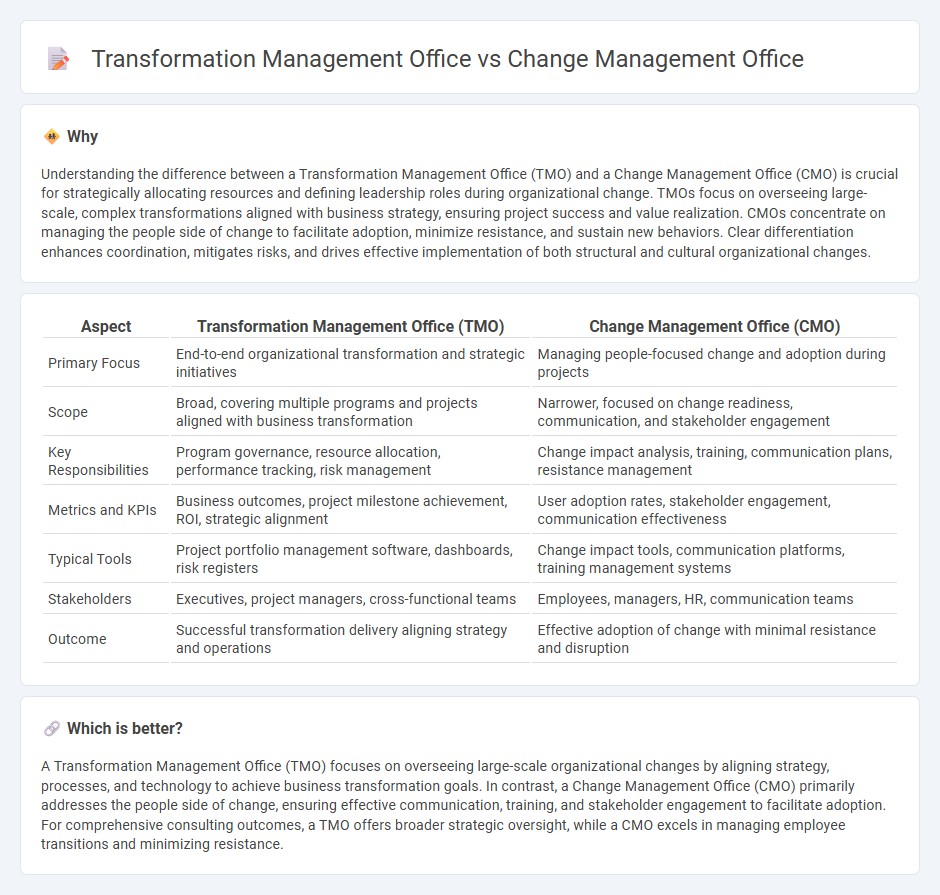
Transformation Management Office (TMO) focuses on large-scale organizational change involving multiple projects and strategic initiatives, ensuring alignment with business goals and driving long-term growth. Change Management Office (CMO) specializes in managing people-side transitions, communication, and adoption strategies to minimize resistance and enhance employee engagement during specific changes. Explore the distinct roles and benefits of TMO and CMO to optimize your organization's change efforts.
Why it is important
Understanding the difference between a Transformation Management Office (TMO) and a Change Management Office (CMO) is crucial for strategically allocating resources and defining leadership roles during organizational change. TMOs focus on overseeing large-scale, complex transformations aligned with business strategy, ensuring project success and value realization. CMOs concentrate on managing the people side of change to facilitate adoption, minimize resistance, and sustain new behaviors. Clear differentiation enhances coordination, mitigates risks, and drives effective implementation of both structural and cultural organizational changes.
Comparison Table
| Aspect | Transformation Management Office (TMO) | Change Management Office (CMO) |
|---|---|---|
| Primary Focus | End-to-end organizational transformation and strategic initiatives | Managing people-focused change and adoption during projects |
| Scope | Broad, covering multiple programs and projects aligned with business transformation | Narrower, focused on change readiness, communication, and stakeholder engagement |
| Key Responsibilities | Program governance, resource allocation, performance tracking, risk management | Change impact analysis, training, communication plans, resistance management |
| Metrics and KPIs | Business outcomes, project milestone achievement, ROI, strategic alignment | User adoption rates, stakeholder engagement, communication effectiveness |
| Typical Tools | Project portfolio management software, dashboards, risk registers | Change impact tools, communication platforms, training management systems |
| Stakeholders | Executives, project managers, cross-functional teams | Employees, managers, HR, communication teams |
| Outcome | Successful transformation delivery aligning strategy and operations | Effective adoption of change with minimal resistance and disruption |
Which is better?
A Transformation Management Office (TMO) focuses on overseeing large-scale organizational changes by aligning strategy, processes, and technology to achieve business transformation goals. In contrast, a Change Management Office (CMO) primarily addresses the people side of change, ensuring effective communication, training, and stakeholder engagement to facilitate adoption. For comprehensive consulting outcomes, a TMO offers broader strategic oversight, while a CMO excels in managing employee transitions and minimizing resistance.
Connection
Transformation Management Office (TMO) and Change Management Office (CMO) are closely connected through their shared focus on driving organizational change and ensuring successful project outcomes. TMO oversees large-scale transformation initiatives by aligning strategic goals with operational execution, while CMO specializes in managing the human and cultural aspects of change to secure stakeholder engagement and adoption. Their collaboration ensures seamless integration of change strategies with project management frameworks, optimizing overall transformation effectiveness.
Key Terms
Governance Structure
A Change Management Office (CMO) primarily oversees the execution of change initiatives within an organization's existing governance framework, ensuring alignment with strategic goals and seamless stakeholder engagement. In contrast, a Transformation Management Office (TMO) governs comprehensive, organization-wide transformation programs, integrating cross-functional governance structures to manage complex changes and deliver strategic value. Discover more about how these distinct governance structures impact organizational agility and success.
Stakeholder Alignment
The Change Management Office (CMO) primarily ensures stakeholder alignment by managing communication, engagement, and resistance during organizational changes, while the Transformation Management Office (TMO) drives alignment through strategic initiatives that reshape business models and culture. CMOs focus on the human side of change to secure buy-in and minimize disruptions, whereas TMOs align stakeholders around long-term transformation goals and innovation. Explore more to understand how each office uniquely facilitates stakeholder alignment for successful organizational change.
Implementation Framework
The Change Management Office (CMO) primarily focuses on guiding organizational change initiatives by establishing structured processes to manage stakeholder engagement, communication, and training within the Implementation Framework. In contrast, the Transformation Management Office (TMO) oversees comprehensive, strategic shifts encompassing multiple projects and business units, emphasizing alignment with long-term goals and continuous performance tracking. Explore how integrating both approaches can optimize your organization's transformation success and implementation effectiveness.
Source and External Links
Best 2024 Guide to Establish and Manage a Change Management Center of Excellence - This guide outlines the establishment and management of a Change Management Center of Excellence, providing structured change management services within organizations.
Change Management Office Whitepaper - This whitepaper discusses the benefits and structure of a Change Management Office, emphasizing its role in governing and implementing organizational change initiatives.
The Change Management Office (CMO) - This article explores the role of a Change Management Office in building organizational change management capabilities and enhancing project success rates.
 dowidth.com
dowidth.com